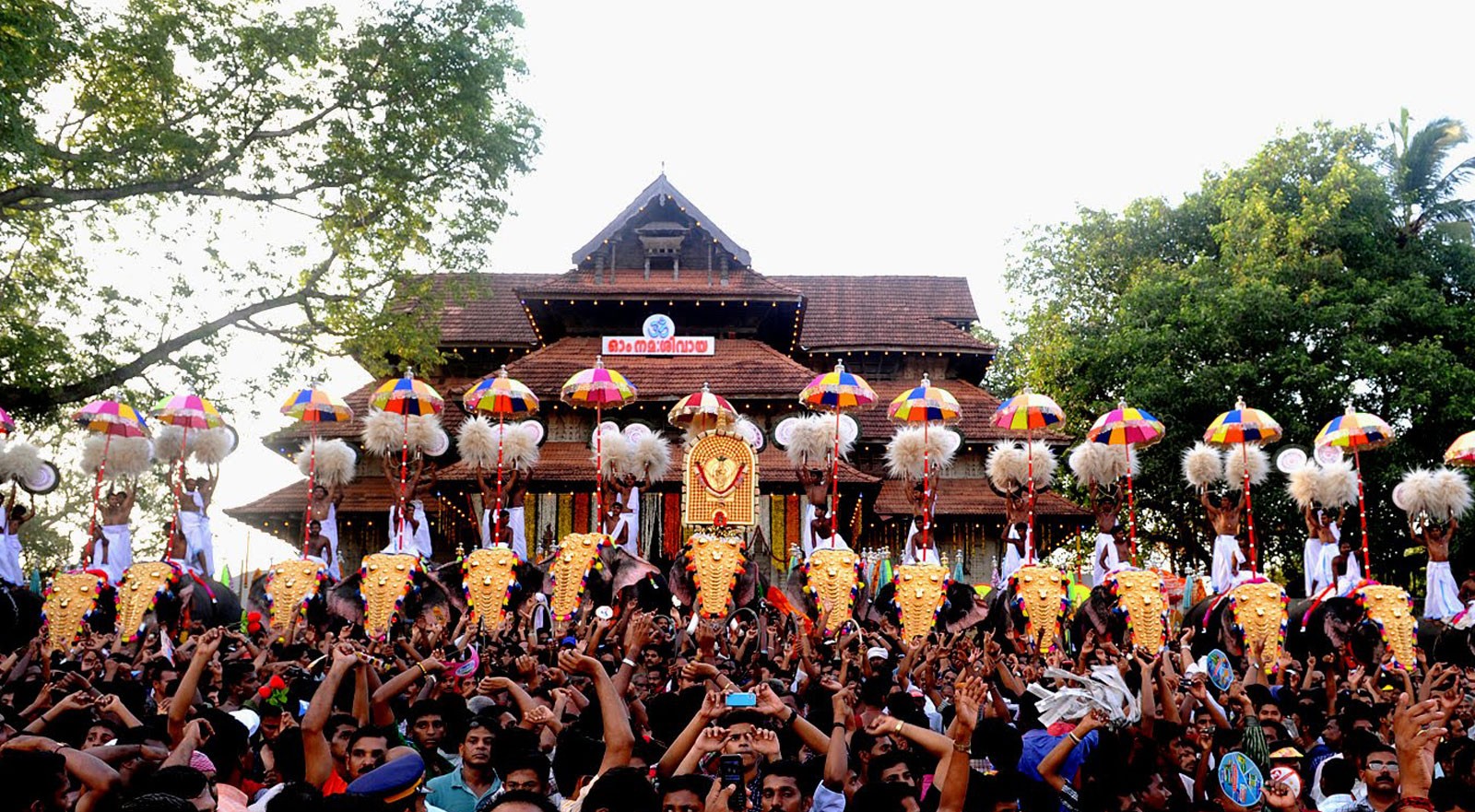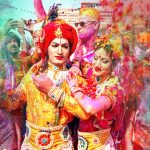The Thrissur Pooram is the most famous of all Pooram festivals and has been celebrated for over two centuries now. The festival entails spectacular procession of caparisoned elephants and enthralling percussion performances in a continuity of 36 hours beginning at 6 am and stretching up to 12 noon the next day. The festival is undoubtedly a rare treat both for the eyes and the ears.
Unlike most other temple festivals, Thrissur Pooram is participated and conducted by people across all barriers of religion and caste.
When is it celebrated?
The Thrissur Pooram is celebrated in the month of Medom according to Malayalam calendar. This falls on April-May months. This year it is being celebrated on 25th and 26 th of april.
Traditions
Adhering to the medieval Peruvanam or Pooram tradition, the festival is confined to the temples of Devi (goddess) and Sastha (divine combination of Shiva and Vishnu) and ten other deities from the neighboring temples pay obeisance to the presiding deity of Thrissur. The only spectator of the Pooram events is Lord Siva at the Sree Vadakkunnathan temple, situated in the heart of the town. Apart from Him the principle divine participants are Paramekkavu and Tiruvambadi, close to the Vadakunnathan temple.
Also participating and known as ‘Cherupooram’ are the suburban temples at Kanimangalam, Karamukku, Choorakkattukara, Laloor, Ayyanthole, Neithilakkavu and Chembukkavu, Panamukkampilly, which takes the number of deities to 8. The sprawling Thekkinkadi maidan, encircling the Vadakumnathan temple, is the main venue of the festival.

History
This festival was introduced by Sakthan Thampuran, the Maharaja of the erstwhile Cochin State in the late eighteenth century and is now the most famous festival in Kerala with the largest fan following from all parts of the country. Much before the grand celebrations at Thrissur temple, the largest temple festival in Kerala was mainly a one-day festival held at Aarattupuzha known as Arattupuzha Pooram.
However, many believe that once it so happened that due to incessant rains, the participating temples of the city of Thrissur were late for the Arattupuzha Pooram and eventually denied access to the Pooram procession. The temples which were denied entry informed about the incident to their Maharaja who in turn started the grand Thrissur Pooram festival. It is said that the Maharaja unified as many as 10 temples in and around Vadakkunnathan Temple and organised the celebration of Thrissur Pooram as a mass festival. Sakthan Thampuran invited adjoining temples with their deities to Thrissur to pay obeisance to Lord Vadakkunnathan (Lord Shiva) the presiding deity of the Vadakkunnathan Temple.
Celebrations
The Pooram Festival is celebrated by two rival groups representing the two divisions of Thrissur Paramekkavu and Thiruvambadi challenging and vowing to overshadow each other with a more magnificent display of fireworks. Each group is allowed to display a maximum of fifteen elephants. The parties keep no stone unturned to secure the best elephants in South India and the most artistic parasols, to adorn the elephants. The celebrations begin early in the morning and last till the break of dawn, the next day.

The procession of Thiruvambadi Pooram to the grounds of Vadakkumnatha Temple and back is not only important, but also quite enlivening with the marvelous and enchanting effect of the Panchavadyam, a combination of five percussion and wind instruments is to be felt and enjoyed.
The procession taking the representation of the Goddess of Thiruvambadi to Brahmaswam Mutt; arrival of the procession to the mutt accompanied by panchavadyam called madathil varavu; the pooram setout of Paramekkavu temple by noon and the one-hour long chembada melam (melam means orchestra); Ilanjithara melam (orchestra held in front of the Ilanji tree); Thekkotirakkam ; meeting of the two temple groups of Thiruvambadi and Paramekkavu; Kudamattom (exchange of colourful parasols), the small-scale fireworks; the panchavadyam (traditional temple orchestra) at night; the major fireworks at early morning; the pakal pooram held on the next day; the fireworks following it and finally the conclusion of pooram festivities with the ceremonial departure called upacharam cholli piriyal are the main events of the pooram festival.
The goddesses of Thiruvambadi and Paramekkavu are believed to be taking part in the pooram. Though the presiding deity at Thiruvambadi is Lord Krishna, it is the second in importance deity of Goddess Bhagavati that takes part in the pooram. There are also eight other temples taking part, but some exclusive rights as part of pooram are vested with Paramekkavu and Thiruvambadi temples. Those rights include rights on the path surrounding the Vadakkumnathan temple and also fireworks and exchange of parasols.
The festivities on the main day commence with the arrival of poorams from eight temples. By 6.30 in the morning, the first pooram of Kanimangalam Sastha temple will arrives at the Vadakkumnathan temple, followed by others like Karamukku Bhagavathy, Choorakattukavu Bhagavathy, Naithilakattu Bhagavathy, Laloor Bhagavathy, Panayckambilli Sastha, Ayanthol Karthiyayani Bhagavathy, and Chembookavu Bhagavathy.

Fireworks
Fireworks are an integral part of Kerala’s temple festivals, but the Thrissur Pooram is referred to as ”the mother of all” firework and temple celebrations. It sets the benchmark for Kerala’s annual temple festival celebrations. But after last April’s tragedy at the Puttingal temple in Kollam, when about 110 people were killed and 700 injured after a stray firework fell into stockpile of explosives, the government and the Kerala High Court have restricted the use of fireworks during temple festivals.
Last year after the tragedy centre has given permission to the ‘Fireworks show’ to go on but with a little less sparkle. On Last day of the festivities at Kerala’s biggest annual fireworks display on the penultimate day of the Thrissur Pooram temple festival will lack its usual bang.
While giving the green signal to the pyrotechnics display at the Thrissur Pooram on saturday the Petroleum and Explosives Safety Organisation under the Centre laid down several restrictions, including a ban on the use of firecrackers with dynamite or potassium chloride. The Centre has also cleared only the use of low-decibel explosives.

Ramachandran
Year after year, lakhs of people come to participate in the festival. This includes tourists who are delighted by the sheer grandeur of the celebrations. A spectacular array of the finest elephants come together amidst the grandeur of traditional drum beats and fireworks. This year attraction is Ramachandran, the celebrity elephant of Kerala opening the gates at the Vadakkunnathan temple to begin the rituals. The 53-year-old is branded the most dangerous captive elephant in the state, having killed a record 11 people and 3 elephants in its lifetime. It is also the most popular tusker with a fan following of thousands, perhaps giving close competition to Mollywood superstars in the state.
========
Must Read : Asaram Bapu Case : A Timeline of Events









